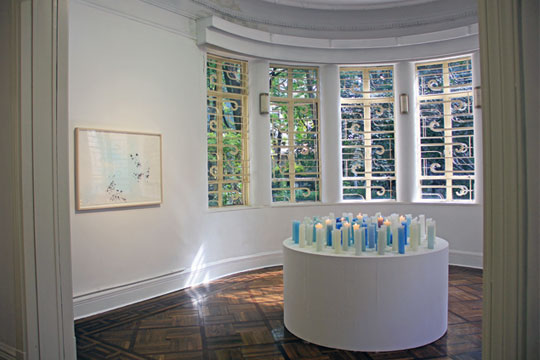SPENCER FINCH & BYRON KIM: DAY AND NIGHT
| March 28, 2014 | Post In 2014年2月号

2013
James Cohan Gallery,
Shanghai
The American poet Emily Elizabeth Dickinson once wrote: “To make a prairie, it takes a clover and one bee, / One clover, and a bee. / And revery.” For Spencer Finch, making a glacier takes a few candles to burn and then fade out (Shanghai Glacier). Finch regularly refers to the poems of Emily Dickinson, though in his work, poetry is written with color and light. Another work, titled Winter Light, Paris – Dusk, consists simply of a blue and white striped light box: Finch uses filter lenses to conduct an almost scientific analysis of the light of Paris at dusk, extracting information which was then applied to material. In his own words: “This is a kind of investigation into ways of using non-traditional, but still very precise, methods to portray scenery.” Similarly, the fluorescent light and filters in Evening Star and the “weave” of colored lines in Study for Garden of Eden I both convey a simple and concise poetry, simply demonstrating the process of the simplification of an impression—the details are left for the viewer to imagine. In the photographic series “Optical Study,” the artist documented the famous lily-pond designed by the French painter Monet, located in the small French town of Giverny. Focusing on reflections on the surface of a lily pond, Finch’s photographs recall early Impressionism, creating alternate perceptions of optical illusion and poetic tension.
In the adjoining gallery are the works of another American artist, Byron Kim, whose work gives off an even more simple and restrained impression: there are only paintings, and only of the sky. The series “City Nights” depicts New York nightscapes, the strange gray-blue of darkness afflicted by urban lighting, swathes of muddied light, and not a single star…this scenery easily brings to mind metropolitan Shanghai: looking upwards at night, we are greeted by the same impression, the same complexity of light and murky color. The intentionally inserted “hard edges” are reminiscent of window views from high up a skyscraper, strange square portals into the night sky suggestive of so many narrative possibilities. By contrast, Kim’s “Sunday Painting” series, which began in 2001 and is still in progress, focuses on daylight. For the past dozen years, he has produced a small painting every Sunday, always depicting the sky on that day—sometimes light and breezy, sometimes dark and brooding. On each painting the artist has also left a diary entry. Over the years, these paintings have formed a historical micro-narrative of the life of an individual. Yet concealed within this assiduously repetitive practice and its apparent tranquillity is perhaps a momentous journey.
From these paintings it is clear that Byron Kim is both extremely sensitive to and attentive in his treatment of light. He once said that he is a painter until 2 pm, and after, a conceptual artist—because his studio faces west. His is a pursuit of precision, though one different to Finch’s. Kim focuses on reproducing the exact details of individual experience and spatial perception; although the two artists are both located in New York, in this exhibition we can witness both the empirical spirit of West and the perceptive sensitivity of the East.
The delicate works on display here brim with charm and interest, the kind of which can only belong to the poet or artist. Spencer Finch again quotes Emily Dickinson: “I’ve seen more in my backyard than most have seen travelling around the world.” But in order for any artist to work successfully, his methodology must develop through constant practice and experimentation. While the exhibition title “Day and Night” first appeared vague, after careful consideration it now appears to be the most apt choice: not only does it echo the content and romantic atmosphere of the exhibition, it also bluntly asserts the role of daily life as both the primary and ultimate context of this work.

